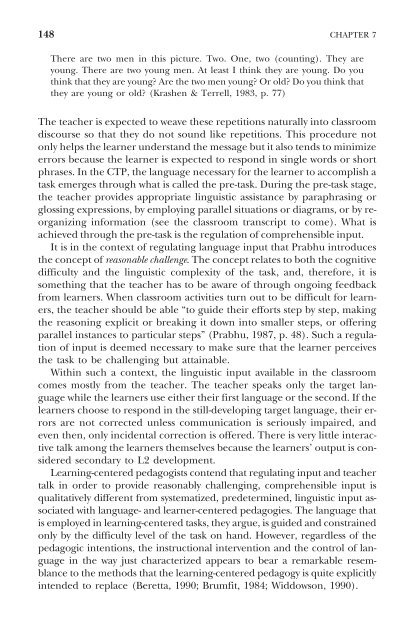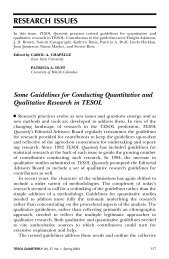url?sa=t&source=web&cd=13&ved=0CC4QFjACOAo&url=http://livelongday.files.wordpress.com/2011/08/kumaraposmethod
url?sa=t&source=web&cd=13&ved=0CC4QFjACOAo&url=http://livelongday.files.wordpress.com/2011/08/kumaraposmethod
url?sa=t&source=web&cd=13&ved=0CC4QFjACOAo&url=http://livelongday.files.wordpress.com/2011/08/kumaraposmethod
You also want an ePaper? Increase the reach of your titles
YUMPU automatically turns print PDFs into web optimized ePapers that Google loves.
148 CHAPTER 7There are two men in this picture. Two. One, two (counting). They areyoung. There are two young men. At least I think they are young. Do youthink that they are young? Are the two men young? Or old? Do you think thatthey are young or old? (Krashen & Terrell, 1983, p. 77)The teacher is expected to weave these repetitions naturally into classroomdiscourse so that they do not sound like repetitions. This procedure notonly helps the learner understand the message but it also tends to minimizeerrors because the learner is expected to respond in single words or shortphrases. In the CTP, the language necessary for the learner to ac<strong>com</strong>plish atask emerges through what is called the pre-task. During the pre-task stage,the teacher provides appropriate linguistic assistance by paraphrasing orglossing expressions, by employing parallel situations or diagrams, or by reorganizinginformation (see the classroom transcript to <strong>com</strong>e). What isachieved through the pre-task is the regulation of <strong>com</strong>prehensible input.It is in the context of regulating language input that Prabhu introducesthe concept of reasonable challenge. The concept relates to both the cognitivedifficulty and the linguistic <strong>com</strong>plexity of the task, and, therefore, it issomething that the teacher has to be aware of through ongoing feedbackfrom learners. When classroom activities turn out to be difficult for learners,the teacher should be able “to guide their efforts step by step, makingthe reasoning explicit or breaking it down into smaller steps, or offeringparallel instances to particular steps” (Prabhu, 1987, p. 48). Such a regulationof input is deemed necessary to make sure that the learner perceivesthe task to be challenging but attainable.Within such a context, the linguistic input available in the classroom<strong>com</strong>es mostly from the teacher. The teacher speaks only the target languagewhile the learners use either their first language or the second. If thelearners choose to respond in the still-developing target language, their errorsare not corrected unless <strong>com</strong>munication is seriously impaired, andeven then, only incidental correction is offered. There is very little interactivetalk among the learners themselves because the learners’ output is consideredsecondary to L2 development.Learning-centered pedagogists contend that regulating input and teachertalk in order to provide reasonably challenging, <strong>com</strong>prehensible input isqualitatively different from systematized, predetermined, linguistic input associatedwith language- and learner-centered pedagogies. The language thatis employed in learning-centered tasks, they argue, is guided and constrainedonly by the difficulty level of the task on hand. However, regardless of thepedagogic intentions, the instructional intervention and the control of languagein the way just characterized appears to bear a remarkable resemblanceto the methods that the learning-centered pedagogy is quite explicitlyintended to replace (Beretta, 1990; Brumfit, 1984; Widdowson, 1990).




